(This post was, in large part, made elsewhere first, but I figure that since I went to the effort to dig up the links, etc, that I might as well put it up here also. If you’ve already seen this, feel free to move along.)
That’s the cover to the 1983 English edition of Jorge Luis Borges‘ short story Tlön, Uqbar, Orbis Tertius. (The story itself dates back to 1940, with the first English edition in the early Sixties.)
Have you read it? It was a pretty ground-breaking word in its time. If you haven’t read it, you can go read it online right now. I’ll wait–it’s not terribly long, something like 5600 words or so. And it’s not just a lovely story, it’s also something that will make you think a bit about language and epistemology, and possibly even about literary criticism.
Everything from here on down will spoil that read for you. Caveat Lector.
So, the quick plot summary, for those who didn’t go read the story, but are not afraid of being spoiled runs like this (swipe to read): [It’s a mystery story, almost an epistemological detective story, in which our protagonist, a fictional version of the author, uncovers an encyclopedia article about the country Uqbar. Following up on this mysterious entry leads him to more and more solid and interesting evidence of the existence of this country, and the world, Tlön that it is on. He discovers a conspiracy of intellectual types, the Orbis Tertius, to imagine into existence this world, causing it to replace the Earth.]
That’s hardly a new idea these days–it’s shown up in a lot of places, but Borges presentation of it is gold, and certainly was one of the earlier ones in the modern literary mainstream.
If you’re one of the comic geeks who reads this, that might sound familiar to you. That’s because one example of Borges’ story influencing people shows up when Grant Morrison more or less lifted the idea entirely for his Orqwith storyline in his much-loved Doom Patrol run. You will recall in that story how [a group of intellectuals had created the Black Book of Orqwith as a kind of game, but the book “infected” reality, taking it over].
Morrison explicitly credits Borges in an interview
I could do an analysis of how the Morrison storyline draws on Borges, but since there’s already a detailed one of those online that might be wasted effort.
(As an aside, the ending of the Orqwith story, wherein the city is destroyed by being made to prove it’s own non-existence, is also a bit of a “lift”, this time a pretty detailed one from the ‘Island of Maya’ chapter in Raymond Smullyan‘s What Is the Name of This Book?–If you’re going to steal, steal good bits.)
All of which is by the way of a prequel to the thing I really wanted to post about. If you’ve read the Borges story, or any of the myriad more recent works that play with this idea (like Doom Patrol), then you will get a very creepy feeling when you read about the Codex Seraphinianus.
Codex Seraphinianus is a much more elaborate work. In fact, it is a highly idiosyncratic magnum opus by an Italian architect indulging his sense of fancy to the hilt. It consists of two volumes in a completely invented language (including the numbering system, which is itself rather esoteric), penned entirely by the author, accompanied by thousands of beautifully drawn colour pictures of the most fantastic scenes, machines, beasts, feasts, and so on. It purports to be a vast encyclopedia of a hypothetical land somewhat like the earth, with many creatures resembling people to various degrees, but many creatures of unheard-of bizarreness promenading throughout the countryside. Serafini has sections on physics, chemistry, mineralogy (including many drawings of elaborate gems), geography, botany, zoology, sociology, linguistics, technology, architecture, sports (of all sorts), clothing, and so on. The pictures have their own internal logic, but to our eyes they are filled with utter non sequiturs.
One summer afternoon in 1978, a voluminous parcel arrived in the offices of the publisher Franco Maria Ricci in Milan, where I was working as a foreign language editor. When we opened it we saw that it contained, instead of a manuscript, a large collection of illustrated pages depicting a number of strange objects and detailed but bizarre operations, each captioned in a script none of the editors recognized. The accompanying letter explained that the author, Luigi Serafini, had created an encyclopedia of an imaginary world along the lines of a medieval scientific compendium: each page precisely depicted a specific entry, and the annotations, in a nonsensical alphabet which Serafini had also invented during two long years in a small apartment in Rome, were meant to explain the illustrations’ intricacies. Ricci, to his credit, published the work in two luxurious volumes with a delighted introduction by Italo Calvino; they are one of the most curious examples of an illustrated book I know. Made entirely of invented words and pictures, the Codex Seraphinianus must be read without the help of a common language, through signs for which there are no meanings except those furnished by a willing and inventive reader.
You can buy a (new) copy from a bookseller in Italy for something like $300 with shipping included. Details here.
For approximately $300 less, you can see every page in this Flickr photoset.
Many of the pictures are grotesque and disturbing, but others are extremely beautiful and visionary. The inventiveness that it took to come up with all these conceptions of a hypothetical land is staggering.
Some people with whom I have shared this book find it frightening or disturbing in some way. It seems to them to glorify entropy, chaos, and incomprehensibility. There is very little to fasten onto; everything shifts, shimmers, slips. Yet the book has a kind of unearthly beauty and logic to it, qualities pleasing to a different class of people: people who are more at ease with free-wheeling fantasy and, in some sense, craziness. I see some parallels between musical composition and this kind of invention. Both are abstract, both create a mood, both rely largely on style to convey content.
Peter Schwenger (an academic at Mount Saint Vincent University here in Halifax) has written a pretty well-known (well-known among those who know about the Codex, that is), and nigh-hallucinatory essay on the book. Here’s a bit:
To assert that the text of the Codex Seraphinianus is equivocal is also to say this of the things depicted therein, the ordered images of a utopia, of a not-place. The text of an ordinary encyclopedia is intended to explicate the things that have been ordered into a system, and while doing so to remove any equivocation in the illustrations through an interpretive commentary; that is what the text contributes to the overall encyclopedic project of “seeing things.” This seeing, however, is accomplished by a selective blindness, a focus attained by filtering out. The encyclopedia is already selective in the things that it has chosen to be worthy of seeing; it becomes more so in the ways it chooses to represent visually phenomena that are always more complex than their depiction on the page. But the final act of seeing performed by the encyclopedia is its text. When scientific classification took shape in the seventeenth century, it was through deliberately limiting the range of perception. As Foucault puts it, in The Order of Things, “Observation, from the seventeenth century onward, is a perceptible knowledge furnished with a series of systematically negative conditions,”10 conditions which excluded certain sense data as too amorphous to be reliable. Vision is considered the most trustworthy mode of perception, but even here what one is allowed to see is what lends itself to ordered description. That description is of the order of language more than the visual order of things: “By limiting and filtering the visible, structure enables it to be transcribed into language. It permits the visibility of the animal or plant to pass over in its entirety into the discourse that receives it” (Foucault 135). The grammatical structures of language, then, are related to the systematic encyclopedia’s broader structures of classification. The tendency to accept both as authoritative and even natural is pulled up short by the glyptolalic text. There language is no longer a transparent means of access to knowledge, but obtrudes itself in a dense and baffling materiality. It is just ordered enough to promise the component of meaning that is associated with language -but that promise is not fulfilled. We are left in the realm of equivocation, both in regard to language and to the broader systematizing project of which it is such an important part.
There was a piece about the book in Believer back in May. It includes tracking down the book’s author. Here’s a little piece of that:
You can go through the book page by page, as I have, but the sensation of discovery never entirely goes away. Also, as with any artistic or literary work, the viewer/reader’s mood and mind-set have a substantial—if not constitutive—effect on the reading and interpretation. Isn’t every piece of art a kind of inkblot? Flipping through the book one day, I was struck by a depiction of what appeared to be a burial custom. A motionless, nondescript man in a black suit is lying on a table. In the next illustration, the table is gone and the man is inside a rectangular block of what looks like glass. The bottom half of the page is taken up by an almost pastoral scene. It looks like a public park, but with low walls and squat buildings constructed of the glasslike blocks, each of which contains a person. On a mall of kempt green grass, neat rows of freestanding blocks look like sculptures in a garden. There are trees. People walk alone or in small groups through a large, simple arch (constructed likewise of the transparent, occupied blocks) into what is apparently an outdoor mausoleum of some sort. It made me think of Richard Brautigan’s book In Watermelon Sugar (1968), where the dead are buried in glass coffins lined with fox fire, so that they will shine forever.
I haven’t purchased a copy yet, but I am terribly afraid I’m going to have to do so soon… (Don’t tell my wife.)



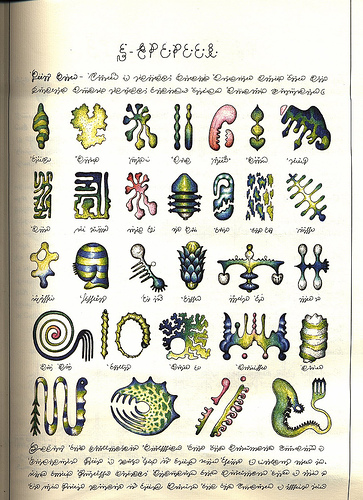
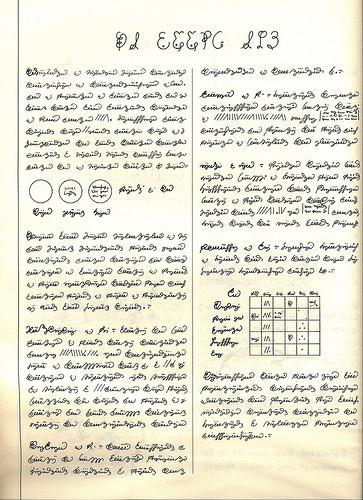
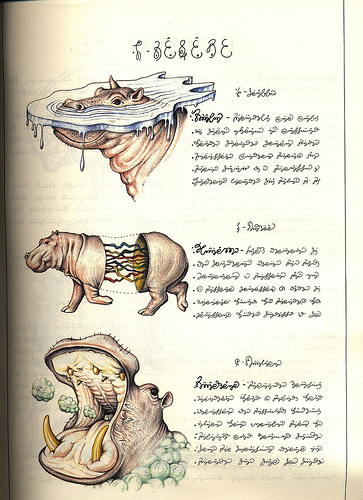
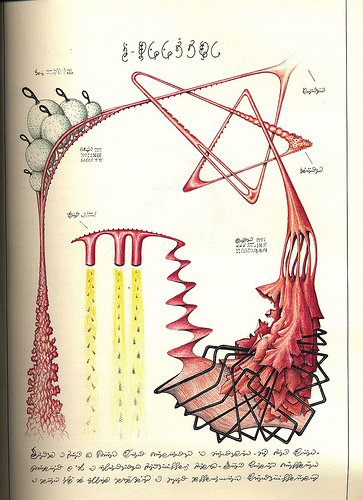
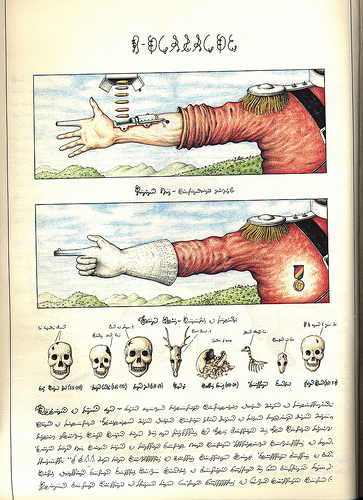

16 comments for “Tlön, Uqbar, Orbis Tertius, Orqwith, and the Codex Seraphinianus”